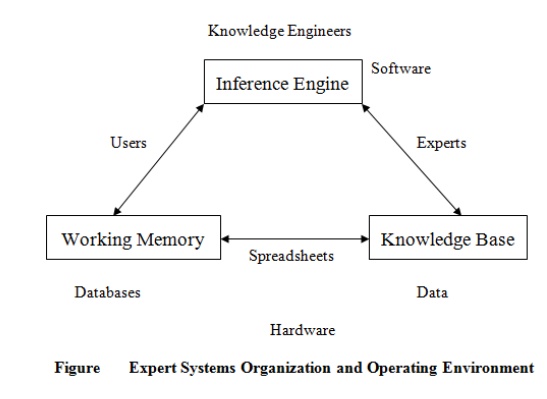Chapter: Artificial Intelligence
Structure of an Expert System
STRUCTURE OF AN EXPERT SYSTEM
The structure of expert systems reflect the knowledge engineers
understanding of the methods of representing knowledge and of how to perform
intelligent decision making tasks with the support of a computer based system.
Complex decisions involve intricate combination of factual and heuristic
knowledge. In order for the computer to be able to retrieve and effectively use
heuristic knowledge, the knowledge must be organized in an easily accessible
format that distinguishes among data, knowledge and control structures. For
this reason expert systems are organized in three distinct levels like:
(a)
Knowledge Base: It consists of problem solving
rules, procedures and intrinsic data relevant to the problem domain. The knowledge base constitutes the problem solving
rules, facts or intuition that a human expert might use in solving problems in
a given problem domain. The knowledge base is usually stored in terms of
if-then rules. The working memory represents relevant data for the current
problem being solved.
b)
Working Memory: It refers to task specific data
for the problem under consideration. This is the dynamic module of the system. It consists of an essential
component called database. In general, the workspace contains a set called rule
base, i.e. it contains a set of rules that to be used by a system at a given
moment.
c)
Inference Engine: This is a generic control
mechanism that applies the axiomatic knowledge in the knowledge base to the task specific data to arrive at some
solution or conclusion. Inference in production systems is accomplished by a
process of chaining through the rules recursively, either in a
forward or in a backward direction until a
conclusion is reached.
These three pieces may very well come from different sources. The
inference engine, such as VP-Expert, may come from a commercial vendor. The
knowledge base may be a specific diagnostic knowledge base compiled by a
consulting firm, and the problem data may be supplied by the end user. A
knowledge base is the nucleus of the expert system structure. A knowledge base
is created by knowledge engineers, who translate the knowledge of real human
experts into rules and strategies. These rules and strategies can change
depending on the prevailing problem scenario. The knowledge base provides the
expert system with the capability to recommend directions for user inquiry. The
system also instigates further investigation into areas that may be important
to a certain line of reasoning but not apparent to the user. The general
structure of an expert system is given in figure .

modularity of an expert system is an important distinguishing
characteristics compared to a conventional computer program. Modularity is
affected in an expert system by the use of three distinct components as shown
in fig 6.2. A good expert system is expected to grow as it learns from user
feedback. Feedback is incorporated into the knowledge base as appropriate to
make the expert system smarter. The dynamism of the application environment for
expert systems is based on the individual dynamism of the components. This can
be classified into three categories as follows.
a)
Most dynamic: The most dynamic part of an
expert system is always the working memory. The content of the working memory, sometimes called the data
structure, changes with each problem situation. Consequently, it is the most
dynamic component of an expert system assuming, of course that it is kept
current.
b)
Moderately dynamic: This part in the expert system is
the knowledge base. The knowledge base need
not change unless a new piece of information arises that indicates a change in
the problem solution procedure. Changes in the knowledge base should be
carefully evaluated before being implemented. In effect, changes should not be
based on just one consultation experience.
c)
Least dynamic: The least dynamic part is the
inference engine. As the control and coding
structure of an inference engine is very strict, so changes are made only
if absolutely necessary to correct a bug or enhance the inferential process.
Commercial inference engines, in particular, change only at the discretion of
the developer. Since frequent updates can be disruptive and costly to clients,
most commercial software developers try to minimize the frequency of updates.
Related Topics